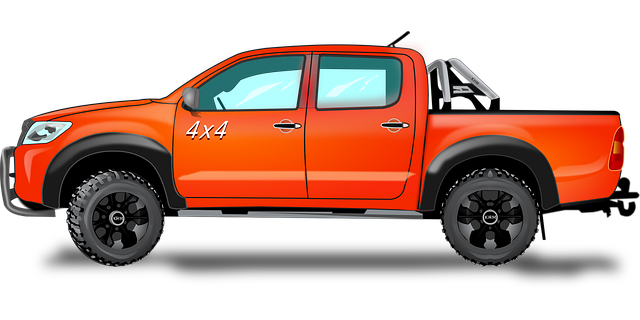Members of Brownsville Jeep Wrangler Clubs emphasize that regular transmission fluid maintenance is critical for the longevity and performance of a Jeep Wrangler. The transmission fluid acts as a lubricant, minimizing friction and preventing overheating within the system. Over time, it degrades due to heat, contamination, and wear, necessitating a complete flush to remove up to 95% of the old fluid and replace it with fresh, high-quality fluid. This process is vital in Brownsville's humid climate, as it helps maintain smooth gear shifts, optimal operating temperatures, and mechanical integrity, especially during off-road excursions. Jeep Wrangler owners should follow manufacturer guidelines for fluid type and maintenance schedules, consult their manuals for specific procedures involving jack stands and transmission port flushes, and ensure proper disposal of the old fluid in accordance with environmental regulations. Adhering to these practices endorsed by the clubs can significantly extend the life of the vehicle's transmission and enhance its reliability, ensuring a safe and enjoyable driving experience for both daily commutes and adventurous off-road outings.
Maintaining your Jeep Wrangler’s performance and longevity is a top priority for off-road enthusiasts, particularly in dynamic environments like those experienced by members of Brownsville Jeep Wrangler Clubs. A crucial aspect of this maintenance is the regular upkeep of the transmission fluid, which plays a vital role in ensuring smooth gear shifts and optimal engine performance. This article delves into the significance of transmission fluid flushes, offering a comprehensive guide tailored for Jeep Wrangler owners. From understanding its function to executing a proper flush, and extending to best practices and expert tips from Brownsville Jeep Wrangler Clubs, this piece is designed to keep your vehicle in peak condition.
- Understanding the Role of Transmission Fluid in Your Jeep Wrangler
- The Importance of Regular Transmission Fluid Flushes for Jeep Wranglers in Brownsville Clubs
- Step-by-Step Guide to Performing a Transmission Fluid Flush on a Jeep Wrangler
- Maintenance Best Practices for Extending the Life of Your Jeep Wrangler's Transmission Fluid
- Tips and Tricks from Brownsville Jeep Wrangler Clubs for Optimal Transmission Fluid Performance
Understanding the Role of Transmission Fluid in Your Jeep Wrangler

Regular maintenance of your Jeep Wrangler’s transmission fluid is pivotal for its longevity and optimal performance, as Brownsville Jeep Wrangler Clubs often emphasize. The transmission fluid in your Jeep acts as a vital lubricant for all the moving parts within the transmission system. It reduces friction, prevents overheating, and ensures that the clutch plates and gears operate smoothly under varying conditions. Over time, this fluid can break down due to heat, contamination, and normal wear, which is where a transmission flush comes into play. A flush replaces almost all of the old fluid with new, restoring its lubricating capabilities and extending the lifespan of your transmission. Members of Brownsville Jeep Wrangler Clubs frequently share experiences and best practices for maintaining their vehicles’ transmissions, highlighting the importance of timely flushes as per the manufacturer’s recommendations. By doing so, you can prevent costly repairs and ensure that your Jeep Wrangler continues to perform reliably, whether you’re navigating off-road trails or cruising through Brownsville’s scenic landscapes. Keeping abreast of these maintenance practices, as advised by the clubs, is a crucial aspect of vehicle ownership for Jeep enthusiasts.
The Importance of Regular Transmission Fluid Flushes for Jeep Wranglers in Brownsville Clubs

Regular maintenance is a cornerstone for the longevity and performance of any vehicle, especially models like the Jeep Wrangler that are known for their rugged terrain capabilities. For members of Brownsville Jeep Wrangler Clubs, the importance of transmission fluid flushes cannot be overstated. The humid climate of Brownsville can create an environment where moisture condenses within the transmission system, potentially leading to corrosion and degradation of the transmission’s internal components. By scheduling routine transmission fluid flushes, Wrangler owners in these clubs can remove contaminants, ensure optimal gear shifts, and maintain the efficiency of the vehicle’s automatic or manual transmission. This preventative measure not only extends the life of the transmission but also ensures that the Jeep Wrangler remains reliable, both on the open road and during off-road adventures with club members. Moreover, the flush helps in maintaining the correct operating temperatures, which is critical for the mechanical integrity of the transmission. In the context of Brownsville’s climate and terrain, this practice becomes even more significant, as the demands placed on a Wrangler’s transmission are often higher than those encountered by vehicles in less challenging environments. Thus, for the enthusiasts who frequent Brownsville Jeep Wrangler Clubs, maintaining a strict schedule for transmission fluid flushes is an essential part of vehicle care and a commitment to safe and enjoyable driving experiences.
Step-by-Step Guide to Performing a Transmission Fluid Flush on a Jeep Wrangler

Maintaining the transmission fluid in your Jeep Wrangler is a critical aspect of vehicle care, and for owners of this iconic off-road vehicle, staying on top of maintenance can significantly extend its lifespan. Brownsville Jeep Wrangler Clubs often share valuable tips and techniques, and one such practice is performing a transmission fluid flush. This procedure involves replacing the old transmission fluid with new, clean fluid to restore optimal performance and ensure the longevity of the transmission system.
Before beginning the flush, it’s crucial to refer to your Jeep Wrangler’s manual for specific recommendations on the type of transmission fluid required. Ensure you have the necessary tools and fluids at hand, including a high-quality transmission flush, fresh transmission fluid that meets the vehicle’s specifications, and appropriate drain pans to catch the old fluid. Start by safely lifting the Jeep Wrangler with a jack stand to access the transmission pan. Locate the drain plug at the bottom of the pan and carefully remove it to allow the old fluid to drain out completely into the prepared pan. Once drained, clean the pan area thoroughly to prevent debris from mixing with the new fluid. Replace the drain plug and remove the transmission pan bolts to access the transmission fluid lines. Attach the flush machine according to its instructions, ensuring a secure connection between the machine and the transmission’s flush port. Run the flush as per the machine’s guidelines, allowing it to circulate through the transmission system and remove accumulated sludge and particles. After completing the flush, replace the pan bolts and reinstall the drain plug. Lower the Jeep Wrangler from its jack stands and disconnect the battery to reset the transmission computer. Refill the transmission with the new fluid, ensuring it’s at the correct level and type as per your manual. Remember to properly dispose of the old fluid according to local environmental regulations. Brownsville Jeep Wrangler Clubs can attest to the effectiveness of regular transmission fluid flushes in maintaining the health of their vehicles, contributing to a smoother driving experience on both city streets and off-road adventures.
Maintenance Best Practices for Extending the Life of Your Jeep Wrangler's Transmission Fluid

Regular maintenance is pivotal for ensuring the longevity and optimal performance of your Jeep Wrangler’s transmission system. Engaging with Brownsville Jeep Wrangler Clubs can provide valuable insights into best practices tailored specifically for such vehicles. Members often share experiences and tips on extending the life of the transmission fluid, which is a critical aspect of vehicle upkeep. It’s recommended to consult the owner’s manual for the manufacturer’s guidelines on transmission fluid type and maintenance intervals. Typically, synthetic ATF (Automatic Transmission Fluid) is preferred due to its superior performance under extreme conditions, often outlasting conventional fluids.
To maximize the lifespan of your Jeep Wrangler’s transmission fluid, it’s essential to monitor the fluid level and condition at regular intervals. This can be facilitated by a proper inspection schedule as part of routine maintenance. During these checks, ensure that the transmission fluid is clean and at the appropriate level. If you detect any signs of contamination or if the fluid level is low, address these issues promptly. A transmission flush should be performed according to the vehicle’s recommended service schedule. This process not only replaces the old fluid but also cleans the system, removing sludge and debris that can accelerate wear and tear. Engaging with local Brownsville Jeep Wrangler Clubs can help you find a trustworthy mechanic or service center experienced in performing these flushes without compromising your vehicle’s transmission health. By adhering to these maintenance best practices, you can extend the life of your Jeep Wrangler’s transmission fluid and ensure that your vehicle remains reliable and enjoyable for years to come.
Tips and Tricks from Brownsville Jeep Wrangler Clubs for Optimal Transmission Fluid Performance

Members of the Brownsville Jeep Wrangler Clubs are well-versed in the intricacies of vehicle maintenance, particularly when it comes to transmission fluid performance. One key tip they often share is the importance of consulting the owner’s manual for specific recommendations on transmission fluid type and maintenance intervals. This ensures that the fluid used meets the exacting standards set by the manufacturer, which can vary between models and years. Additionally, these clubs emphasize the need for a clean environment when checking or changing the transmission fluid. They advise against performing this task on surfaces that could contaminate the fluid, as even a small amount of dirt or debris can compromise its integrity and lead to transmission issues.
For those looking to extend the life of their transmission fluid and ensure optimal performance, the Brownsville Jeep Wrangler Clubs suggest investing in high-quality fluid that meets or exceeds the original equipment manufacturer’s (OEM) specifications. They also recommend a flush rather than a simple drain and fill when changing the transmission fluid. This method removes up to 95% of the old fluid, which is crucial for preventing sludge buildup and maintaining the transmission’s efficiency. Club members also stress the importance of regular monitoring of the transmission fluid level and condition, as early detection of any changes can prevent minor issues from becoming major problems. By following these practices, Jeep Wrangler owners in Brownsville can enjoy a smoother, more reliable driving experience, with the added benefit of potentially increasing the lifespan of their vehicle’s transmission.
In wrapping up our exploration of transmission fluid maintenance in Jeep Wranglers, particularly within the active and knowledgeable Brownsville Jeep Wrangler Clubs, it’s clear that regular attention to this critical component is paramount for optimal performance and longevity. By understanding the role of transmission fluid, Jeep Wrangler owners can effectively maintain their vehicles’ health through consistent flushes and adherence to maintenance best practices. The insights shared by Brownsville Jeep Wrangler Clubs highlight the importance of this routine upkeep and offer practical tips that can extend the life of your transmission fluid. With these guidelines in hand, Jeep enthusiasts can confidently maintain their vehicles, ensuring they continue to handle the diverse terrains of Brownsville with ease and reliability.
